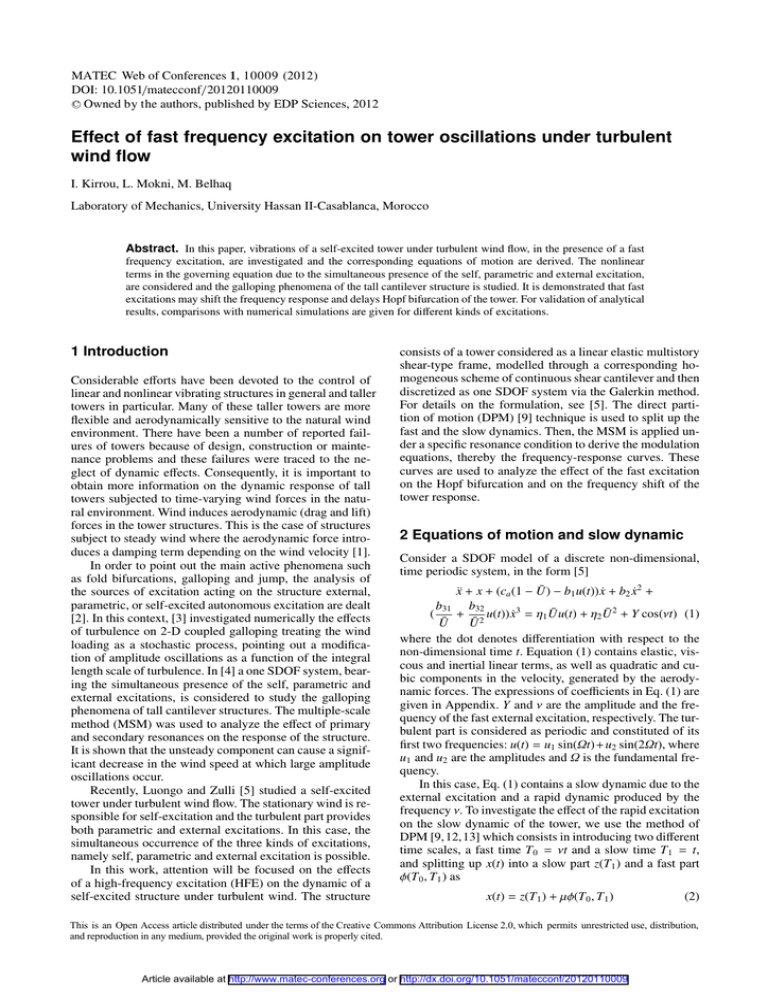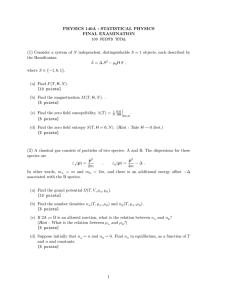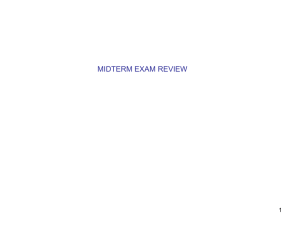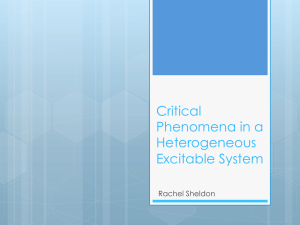Effect of fast frequency excitation on tower oscillations under turbulent
advertisement

MATEC Web of Conferences 1, 10009 (2012) DOI: 10.1051/matecconf/20120110009 C Owned by the authors, published by EDP Sciences, 2012 Effect of fast frequency excitation on tower oscillations under turbulent wind flow I. Kirrou, L. Mokni, M. Belhaq Laboratory of Mechanics, University Hassan II-Casablanca, Morocco Abstract. In this paper, vibrations of a self-excited tower under turbulent wind flow, in the presence of a fast frequency excitation, are investigated and the corresponding equations of motion are derived. The nonlinear terms in the governing equation due to the simultaneous presence of the self, parametric and external excitation, are considered and the galloping phenomena of the tall cantilever structure is studied. It is demonstrated that fast excitations may shift the frequency response and delays Hopf bifurcation of the tower. For validation of analytical results, comparisons with numerical simulations are given for different kinds of excitations. 1 Introduction Considerable efforts have been devoted to the control of linear and nonlinear vibrating structures in general and taller towers in particular. Many of these taller towers are more flexible and aerodynamically sensitive to the natural wind environment. There have been a number of reported failures of towers because of design, construction or maintenance problems and these failures were traced to the neglect of dynamic effects. Consequently, it is important to obtain more information on the dynamic response of tall towers subjected to time-varying wind forces in the natural environment. Wind induces aerodynamic (drag and lift) forces in the tower structures. This is the case of structures subject to steady wind where the aerodynamic force introduces a damping term depending on the wind velocity [1]. In order to point out the main active phenomena such as fold bifurcations, galloping and jump, the analysis of the sources of excitation acting on the structure external, parametric, or self-excited autonomous excitation are dealt [2]. In this context, [3] investigated numerically the effects of turbulence on 2-D coupled galloping treating the wind loading as a stochastic process, pointing out a modification of amplitude oscillations as a function of the integral length scale of turbulence. In [4] a one SDOF system, bearing the simultaneous presence of the self, parametric and external excitations, is considered to study the galloping phenomena of tall cantilever structures. The multiple-scale method (MSM) was used to analyze the effect of primary and secondary resonances on the response of the structure. It is shown that the unsteady component can cause a significant decrease in the wind speed at which large amplitude oscillations occur. Recently, Luongo and Zulli [5] studied a self-excited tower under turbulent wind flow. The stationary wind is responsible for self-excitation and the turbulent part provides both parametric and external excitations. In this case, the simultaneous occurrence of the three kinds of excitations, namely self, parametric and external excitation is possible. In this work, attention will be focused on the effects of a high-frequency excitation (HFE) on the dynamic of a self-excited structure under turbulent wind. The structure consists of a tower considered as a linear elastic multistory shear-type frame, modelled through a corresponding homogeneous scheme of continuous shear cantilever and then discretized as one SDOF system via the Galerkin method. For details on the formulation, see [5]. The direct partition of motion (DPM) [9] technique is used to split up the fast and the slow dynamics. Then, the MSM is applied under a specific resonance condition to derive the modulation equations, thereby the frequency-response curves. These curves are used to analyze the effect of the fast excitation on the Hopf bifurcation and on the frequency shift of the tower response. 2 Equations of motion and slow dynamic Consider a SDOF model of a discrete non-dimensional, time periodic system, in the form [5] ẍ + x + (ca (1 − Ū) − b1 u(t)) ẋ + b2 ẋ2 + b31 b32 + 2 u(t)) ẋ3 = η1 Ūu(t) + η2 Ū 2 + Y cos(νt) (1) ( Ū Ū where the dot denotes differentiation with respect to the non-dimensional time t. Equation (1) contains elastic, viscous and inertial linear terms, as well as quadratic and cubic components in the velocity, generated by the aerodynamic forces. The expressions of coefficients in Eq. (1) are given in Appendix. Y and ν are the amplitude and the frequency of the fast external excitation, respectively. The turbulent part is considered as periodic and constituted of its first two frequencies: u(t) = u1 sin(Ωt)+u2 sin(2Ωt), where u1 and u2 are the amplitudes and Ω is the fundamental frequency. In this case, Eq. (1) contains a slow dynamic due to the external excitation and a rapid dynamic produced by the frequency ν. To investigate the effect of the rapid excitation on the slow dynamic of the tower, we use the method of DPM [9,12,13] which consists in introducing two different time scales, a fast time T 0 = νt and a slow time T 1 = t, and splitting up x(t) into a slow part z(T 1 ) and a fast part φ(T 0 , T 1 ) as x(t) = z(T 1 ) + µφ(T 0 , T 1 ) (2) This is an Open Access article distributed under the terms of the Creative Commons Attribution License 2.0, which permits unrestricted use, distribution, and reproduction in any medium, provided the original work is properly cited. Article available at http://www.matec-conferences.org or http://dx.doi.org/10.1051/matecconf/20120110009 MATEC Web of Conferences where z describes the slow main motions at time-scale of oscillations, µφ stands for an overlay of the fast motions and µ indicates that µφ is small compared to z. Since ν is considered as a large parameter, we choose µ ≡ ν−1 for convenience. The fast part µφ and its derivatives are assumed to be 2π−periodic functions of fast time T 0 with zero mean value with respect to this time, so that < x(t) >= R 2π 1 () dT 0 defines time-averaging opz(T 1 ) where <>≡ 2π 0 erator over one period of the fast excitation with the slow j time T 1 fixed. Introducing Dij ≡ ∂∂j Ti yields dtd = νD0 + D1 , d2 dt2 = ν2 D20 + 2νD0 D1 + D21 and substituting Eq. (2) into Eq. (1) gives µ−1 D20 φ + D21 z + 2D0 D1 φ + D21 φ + (ca (1 − Ū) − b1 u(t))(D1 z + D0 φ + µD1 φ) + z + µφ + b2 ((D1 z)2 + 2D1 z(D0 φ + µD1 φ) + (D0 φ)2 + 2µD0 φD1 φ + (µD1 φ)2 ) + b31 b32 + 2 u(t))((D1 z)3 + 3(D1 z)2 (D0 φ + µD1 φ) + ( Ū Ū 3(D1 z)(D0 φ + µD1 φ)2 + (D0 φ + µD1 φ)3 ) = η1 Ūu(t) + η2 Ū 2 + Y cos(νt) (3) Averaging (3) leads to D21 z + (ca (1 − Ū) − b1 u(t))D1 z + z + b2 ((D1 z)2 + b31 b32 + 2 u(t))((D1 z)3 + < (D0 φ)2 > + < (µD1 φ)2 >) + ( Ū Ū 3D1 z(< (D0 φ)2 > + < (µD1 φ)2 >)) = η1 Ūu(t) + η2 Ū 2 (4) 3 z(t) = z0 (t0 , t1 ) + εz1 (t0 , t1 ) + O(ε2 ) µD1 φ) + µφ + b2 (2D1 z(D0 φ + µD1 φ) + (D0 φ)2 − < (D0 φ)2 > +2µD0 φD1 φ + (µD1 φ)2 − < (µD1 φ)2 >) + b32 b31 + φ 2 u(t))(3(D1 z)2 (D0 + µD1 φ) + 3D1 z(D0 φ)2 − ( Ū Ū 3D1 z < (D0 φ)2 > +6D1 zµ(D0 φD1 φ) + 3D1 z(µD1 φ)2 − 3D1 z < (µD1 φ)2 > +(D0 φ)3 + 3µ(D0 φ)2 D1 φ +3D0 φ(µD1 φ)2 + µD1 φ) = Y cos(T 0 ) (5) Using the so-called inertial approximation [9], i.e. all terms in the left-hand side of Eq. (5), except the first, are ignored, one obtains φ = −µY cos(T 0 ) (6) Inserting φ from Eq. (6) into Eq. (4), using that < cos2 T 0 >= 1/2, and neglecting terms of orders greater than three in z, give the equation governing the slow dynamic of the motion z̈ + (ca (1 − Ū) − b1 u(t) + H( b2 ż2 + ( b31 b32 + 2 u(t)))ż + z + φ + Ū Ū b31 b32 + 2 u(t))ż3 = −G + η1 Ūu(t) + η2 Ū 2 Ū Ū where H = 2 3Y 2ν2 (7) 2 2Y and G = − b2ν 2 . 3 The multiple scales analysis To obtain the frequency response equation, we perform a perturbation method. Introducing a bookkeeping param1 1 eter ε and scaling as z = ε 2 z, b1 = εb1 , b2 = ε 2 b2 , (8) where ti = εi t. In terms of the variables ti , the time deriva2 tives become dtd = d0 + εd1 + O(ε2 ) and dtd 2 = d02 + 2εd0 d1 + j O(ε2 ), where dij = ∂∂j ti . Substituting Eq. (8) into Eq. (7), we obtain the following equation and equating coefficients of the same power of , we obtain Ordre O(ε0 ): d02 z0 + z0 = −G (9) Ordre O(ε1 ): d02 z1 + z1 = −2d0 d1 z0 + (ca V + b1 u(t0 ) − H(b31 + b32 u(t0 )))(d0 z0 ) − b2 (d0 z0 )2 − (b31 + b32 u(t0 ))(d0 z0 )3 + η1 u(t0 ) + η2 (10) In the case of the principal resonance (Ω = 1 + σ), standard calculations yield the first-order solution z0 = A(t1 ) exp(it0 ) + Ā(t1 ) exp(−it0 ) − G (11) where i is the imaginary unit and A is an unknown complex amplitude. Then, the turbulent part is written as u(t0 , t1 ) = u1 exp(i(1 + σ)t0 ) + u2 exp(2i(1 + σ)t0 ) + cc (12) Subtracting (4) from (3) yields µ−1 D20 φ + 2D0 D1 φ + D21 φ + (ca (1 − Ū) − b1 u(t))(D0 φ + 3 η1 = ε 2 η1 , η2 = ε 2 η2 and H = εH. We assume Ū = 1 + εV and we consider the resonance condition Ω = 1+εσ where σ is a detuning parameter. Using the MSM [2], we seek a two-scale expansion of the solution in the form Substituting Eq. (12) into Eq. (3) and eliminating the secular terms, the modulation equations of the amplitude a and the phase γ are given by 1 1 ȧ = a( (ca V − Hb31 ) + (Hb32 − b1 ) u2 sin(2φ))+ 2 4 (− 38 b31 + b432 u2 sin(2φ))a3 − η12u1 cos(φ) (13) b1 u2 u2 cos(2φ)]+ aφ̇ = a[σ + H b32 cos(2φ) − 4 4 ( b32 u2 cos(2φ))a3 + η1 u1 sin(φ) 8 2 4 Applications and results In this section, we analyze the effect of the amplitude of the fast frequency excitation on the vibration of the tower of for different types of turbulent wind flow. The parameter values used for the present study are taken from [5]. 4.1 Non-turbulent wind flow case Fixed points of Eq. (13), obtained requiring ȧ = φ̇ = 0, represent periodic oscillations of the system. In the absence of turbulence (u1 = u2 = 0), only the first equation of Eq. (13) is interesting. Besides the trivial solution, a = 0, the selfexcitation is responsible for galloping, and given as a=0 r (14) 4(Ca V − Hb31 ) a = 3b31 10009-p.2 CSNDD 2012 The behavior of the system, in the absence of turbulence (u1 = u2 = 0), as given by Eq. (14), for σ = 0, is described in Fig 1. The trivial solution exists everywhere and changes its stability at the bifurcation point. In this figure, we show the effect of the amplitude of the fast frequency excitation on the frequency response of the system. It can be seen from this figure that increasing the amplitude of HFE, the amplitude of the tower response decreases and the Hopf bifurcation point shifts right. Fig. 2. Amplitude versus velocity of the wind when σ = 0, u2 = 0, u1 = 0.1 and ν = 8. Solid line: stable; dashed: unstable. Fig. 1. Equilibrium branches in the absence of turbulent wind, for ν = 8. Solid line: stable; points: unstable. 4.2 Effects of HFE in the case of turbulent wind In this case (u1 , 0, u2 = 0), the modulation equations (13) leads to the following response equation s21 a6 + 2s1 s2 a4 + (s22 + σ2 )a2 + ( η1 u1 2 ) =0 2 (15) where s1 = − 3b831 and s2 = 21 (Ca V − Hb31 ). In Figs. 2 and 3, we study the effect of the amplitude of the HFE on the frequency response. Figure 2 illustrates the amplitude of the tower response versus the velocity of the wind V, for u1 = 0.1 and ν = 8. These plots indicate that as the amplitude of the HFE increases, the amplitude of tower decreases and shifts right. If V is kept fixed and σ is varied, the amplitude of oscillations behave as shown in Fig. 3, where different values of the amplitude Y are considered. We can see in this figure that, in the absence of HFE Y = 0, the response curve has three solutions within the interval (σ ∈ [−0.0001, 0.0001]). It can also be seen that as Y is increased the amplitude of the tower response decreases. Here, only one solution exists. The solid lines correspond to the stable branches, while the points correspond to the unstable ones. To validate the analytical approximation, we integrate (7) numerically using the fourth-order Runge-Kutta method. The comparison demonstrates good agreement between the numerical (circles) and analytical solutions. Fig. 3. Amplitude versus σ when V = 0.117, u1 = 0.033, u2 = 0 and ν = 8. Solid line: stable; dashed: unstable; circle: numerical simulation. where s1 = − 3b831 , s2 = 21 (Ca V − Hb31 ), s3 = (Hb32 − b1 ) u42 and s4 = b32 u42 . Figure 4 shows the amplitude versus the velocity V, as given by (16), in the absence of external excitation (u1 = 0, u2 , 0). The solid lines correspond to the stable branches, while the points correspond to the unstable ones. The plots depict the effect of different values of the amplitude Y, showing that the amplitude of the response decreases and shifts right as Y increases. Fig. 4. Amplitude versus σ when σ = 0, u1 = 0, u2 = 0.1 and ν = 8. Solid line: stable; points: unstable. 4.3 Effects of HFE in the case of parametric excitation of turbulent wind In this case, the system is parametrically excited (u1 = 0, u2 , 0), and the corresponding amplitude response equation is written as (−σa)2 (−s2 a − s1 a3 )2 =1 + (s3 a + s4 a3 )2 (s3 a + 21 s4 a3 )2 (16) 4.4 Effects of HFE in the case of external and parametric excitations of turbulent wind In the case where the external and parametric excitations are both present (u1 , 0, u2 , 0), the amplitude frequency response is shows in Fig. 5. The solid lines correspond to 10009-p.3 MATEC Web of Conferences the stable branches, while the points correspond to the unstable ones. The plots indicate the effect of different values of the amplitude Y. It can be seen that the amplitude of the response decreases as Y increases. Y=0 0.03 0.025 a 0.02 0.015 Y=0.15 0.01 Y=0.18 0.005 0 −1 −0.5 0 σ 0.5 1 −3 x 10 Fig. 5. Amplitude versus σ when V = 0.167, u1 = 0.033, u2 = 0.033 and ν = 8. Solid line: stable; points: unstable. 5 Conclusion In this work, we have investigated the effect of a fast frequency excitation on the response of a tower under turbulent wind flow near the primary resonance. The method of DPM and the MSM are used to drive a slow dynamic. Results from numerical simulations using Runge-Kutta method are also presented for validation. Different kinds of excitations are analyzed in terms of equilibrium branches of the amplitudes. When the wind is non-turbulent, results show that changing the amplitude of the fast excitation, causes the Hopf bifurcations curve to shift right. When the turbulence produces external excitation only, adding fast frequency excitation causes the amplitude response to decrease significantly and to shift right. The same effects are shown on the Hopf bifurcation curve when the turbulence wind produces either parametric excitation or simultaneous external and parametric excitations. References 1. R. Clark, A. Modern, Course in Aeroelasticity, fourth ed, Kluwer Academic Publishers, Dordrecht, The Netherlands, 2004. 2. A. H. Nayfeh, B. Balachandran, Applied Nonlinear Dynamics, John Wiley, New York, 1995. 3. Q. S. Li, J. Q. Fang, A. P. Jeary, Evaluation of 2D coupled galloping oscillations of slender structures. Computers and Structures. 66, 513-523, 1998. 4. M. Abdel-Rohman, Effect of unsteady wind flow on galloping of tall prismatic structures, Nonlinear Dyn. 26, 231-252, 2001. 5. A. Luongo, D. Zulli, Parametric, external and selfexcitation of a tower under turbulent wind flow, J. Sound Vib. 330, 3057-3069, 2011. 6. K. Szabelski, J. Warminski, Self-excited system vibrations with parametric and external excitations, J. Sound Vib. 187, 595-607, 1995. 7. M. Eissa, Y. A. Amer, Vibration control of a cantilever beam subject to both external and parametric excitation, Appl. Math. Comput. 152, 611-619, 2004. 8. J. S. Jensen, Non-linear dynamics of the followerloaded double pendulum with added support-excitation, J. Sound Vib. 215, 125-142, 1998. 9. I. I. Blekhman, Vibrational Mechanics, Nonlinear Dynamic Effects, General Approach, Applications. Singapore: World Scientific 2000. 10. D. M. Tcherniak, The influence of fast excitation on a continuous system, J. Sound Vib. 227, 343-360, 1999. 11. M. Hamdi, M. Belhaq, Self-excited vibration control for axially fast excited beam by a time delay state feedback, Chaos Solutions and Fractals. 41, 521-532, 2009. 12. M. Belhaq, A. Fahsi, Hysteresis suppression for primary and subharmonic 3:1 resonances using fast excitation. Nonlinear Dyn. 57, 275-287, 2009. 13. F. Lakrad, M. Belhaq, Suppression of pull-in instability in MEMS using a high-frequency actuation. Commun Nonlinear Sci Numer Simulat. 15, 3640-3646, 2010. Appendix The expressions of the coefficients of Eq. (1) are √ ρA1 bh`Ūc 3EI 2 b1 ` √ √ , b1 = ca , b2 = − 4ρA ω = π h` m , ca = 2π 3πm 3EIm √ 3EI , 8hŪc m3 b31 = − 3πρA3 b`√ b32 = −b31 , η1 = 4ρA0 bh2 `Ūc2 3π3 EI η2 = η21 , U(t) = Ū + u(t), where ` is the height of the tower, b is the cross-section wide, EI the total stiffness of the single story, m is the mass longitudinal density, h is the inter story height, and ρ is the air mass density. Ai , i = 0, ...3 are the aerodynamic coefficients for the squared cross-section. The dimensional critical velocity is given by √ . Ūc = 4πξρbA3EIm 1 h` Here ξ is the modal damping ratio, depending on both the external and internal dampings: ηh2 c ω + 2mω ξ = 24EI 10009-p.4






![Solution to Test #4 ECE 315 F02 [ ] [ ]](http://s2.studylib.net/store/data/011925609_1-1dc8aec0de0e59a19c055b4c6e74580e-300x300.png)